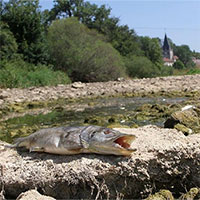It was not until the time of the Egyptian Pharaohs who knew how to embalm. The recipe for preserving mummies dates back 1,500 years.
Dr. Jana Jones, Department of Ancient History, Macquarie University, Australia, and colleagues have just published the results of their team’s analysis of a prehistoric Egyptian corpse.
The mummy, dating from about 3,700 to 3,500 BC, has been kept in a museum in Turin, Italy, from 1901 to the present and is still intact. Until now, it is still thought that it was not until the time of the pharaohs that humans performed mummification. However, the results of the analysis provide convincing evidence that the Egyptians had mummified bodies 1,500 years earlier.
In the past, it was thought that this man’s body was naturally dried by being buried in hot and dry desert sand, but now we can confirm that the body has been preserved.
Along with a number of other studies, this information tells us that the ancient Egyptians who lived before the pharaoh’s time by about 1,500 years or more had knowledge of the process of preserving corpses and conducting religious rituals associated with the pharaoh. regarding beliefs about the afterlife.
Some of the group’s previous studies also analyzed the phenomenon of burial before the funeral rites of prehistoric people in some parts of Central Egypt, who lived long before the time of the pharaohs and were known. techniques for preserving corpses .
These studies report that many prehistoric corpses (about 4,500 – 3,350 BC) unearthed in Badari and Mostagedda, were buried with small bags containing seeds made from tree sap.

The mummy is stored in a museum in Turin, Italy.
This suggests that people at that time used tree sap as a rudimentary way of mummification. The resin here is obtained from several species of trees, in particular pine resin, and as a preservative, is mixed into the mixture used for embalming.
Older studies did not include whole bodies for experimentation, but only pieces of linen used for embalming and kept in museums in the UK. The pieces of cloth were donated to the museum by those who excavated directly and are the only surviving evidence that the bodies were wrapped.
The team found tree sap in those pieces of cloth. However, they did not have any more specimens to expand their research to this day, when they studied human remains found in Turin.
The basic principle of mummification of the ancient Egyptians was to preserve the whole body so that the dead person could be reincarnated in the next life. If that person is unfortunately bitten by a crocodile and loses a leg, they will be fitted with a wooden prosthetic leg for all parts.
Clothed corpses in prehistoric sites are often not carefully examined when excavating, because then in the 19th and early 20th centuries people were only interested in artifacts buried with the corpse. Furthermore, there is no reason to believe that the prehistoric Egyptians used perfumed waxes to preserve the dead.
Like the British, the Italians also conducted excavations to retrieve artifacts for their Museo Egizio museum. The most famous archaeologist might be Ernesto Schiaparelli, the museum’s director from 1895 to 1928.
Mr. Schiaparelli went on to make several trips to Egypt to excavate and purchase mummies and burial paraphernalia from antique dealers, among them the prehistoric human mummies that Dr. access to research.
In 2014, Dr. Jones’ research team and an international team of experts conducted research on this mummy. They took small pieces of fabric and leather for biochemical analysis, radiocarbon dating, textile analysis and DNA analysis of pathogenic bacteria.
Since arriving at the museum in 1901, the mummy has not been chemically preserved, which means almost no chemical contamination or impact, making it an ideal specimen for scientific study. . Chemical analysis of shroud samples taken from the trunk and wrists found vegetable oils or tallow, turpentine and vegetable flavourings.
Pine resin and flavoring are the two main antibacterial agents to repel insects and preserve software. The cloth was dipped in a mixture of melted plastic and flavorings and then used to wrap the body.
Radiocarbon dating of the linen shroud samples dated the mummy to between 3,700 and 3,500 BC. The yarn was spun using the traditional Egyptian linen weaving technique from about 5,000 to 3,600 BC.
Microbiological analysis did not find pathogenic DNA, possibly because pathogenic bacteria did not survive environmental conditions in Egypt or in museums. So we don’t know if this person died of illness or not. In addition, the mummy’s extremely weak, fragile condition did not allow it to be moved for radiographic analysis.
Combined with previous studies, the new findings from this fully organised mummy tell us that prehistoric Egyptians had knowledge of the process of preserving corpses as well as a developed belief system. to the extent that there is a theory of reincarnation.
They were able to find and obtain turpentine from the Eastern Mediterranean, which suggests that long-distance trade was possible. Some burial mounds 200 km away from the site where the mummy was found also found similar materials in the scented wax.
These materials continued to be used until the time of the pharaohs, when mummification was at its peak, some 2,500 years later. This really shows that the talent of the ancient Egyptians was handed down despite the conditions of time and nature.

